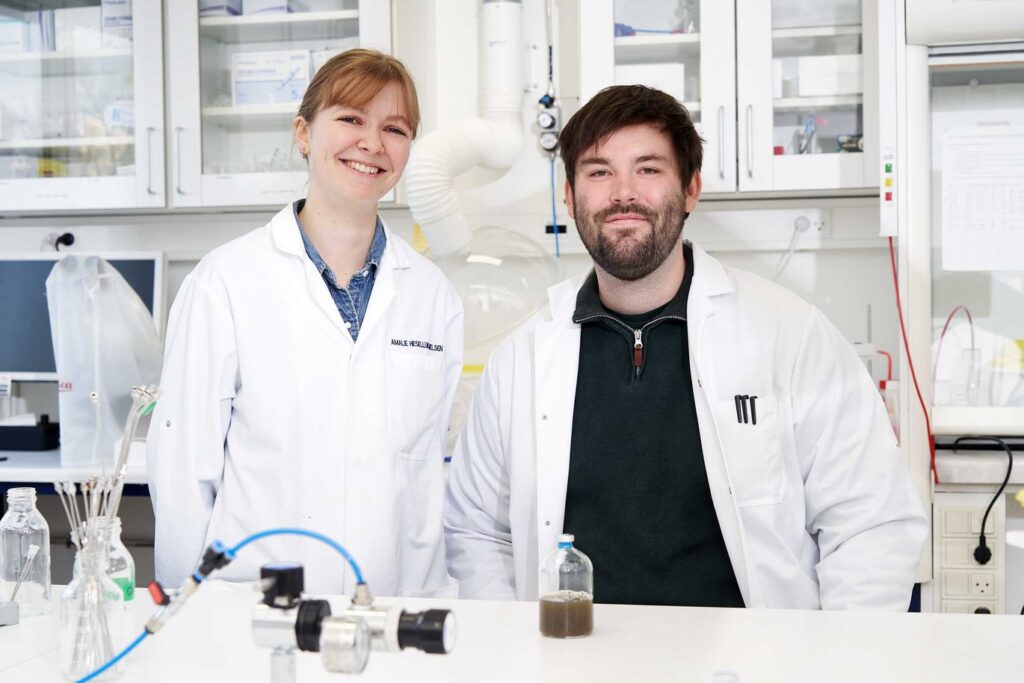CO2-eating bacteria recycles carbon from chimney smoke directly into new products
New research from Aarhus University has revealed how we can make it much cheaper to capture and convert CO2 from industry for usable products. The research has just been published in Nature Communications

Researchers from Aarhus University (AU) have developed a new technology that uses microorganisms to convert the CO2 in flue gas directly for new purposes – for example fuels or substances for the chemicals industry.
The technology can exploit CO2 as a raw material, unlike conventional carbon capture and storage (CCS), which captures carbon from flue gas and converts it into solid matter that can then be stored underground, for example. The research has recently been published in the scientific journal Nature Communications.
"In a net-zero future, we need to use technology that recycles the CO2 we capture instead of continuing to extract more from the ground," says Amalie Kirstine Hessellund Nielsen, a PhD student at the Department of Biological and Chemical Engineering and one of the main authors behind the research.
Hyper-specialised process
Globally, CO2 from flue gases is the biggest contributor to higher concentrations of greenhouse gases in the atmosphere. It is also one the most problematic point sources to get rid of, because the CO2 in flue gases from industrial chimneys, for example, is mixed with other gases and therefore difficult to remove without major additional costs.
This new technology is based on carbon capture and utilisation (CCU), where so-called amine scrubbing removes CO2from flue gases using chemicals that bind the CO2. In conventional carbon capture, the carbon is separated from the chemicals at high temperatures in a closed circuit. The concentrated CO2 can then be refined further in other demanding processes.
The alternative technology proposed by the researchers from AU propose is a new form of bio-integrated carbon capture and utilisation (BICCU), whereby carbon is reused directly in the circuit, avoiding many of the conventional intermediate process steps. The researchers at AU use microorganisms that both remove and convert CO2 from the flue gases directly in the capture unit instead of having to apply high heat.
"Microorganisms are hyper-specialised in the process of absorbing and converting CO2 and they have refined this process over billions of years. We exploit this in our bioreactors. So instead of using heat, we add microorganisms that can extract CO2 from other chemicals allowing us to save money on our heating bills," says Mads Ujarak Sieborg, a postdoc at the Department of Biological and Chemical Engineering and the main author of the new research.
The microorganisms absorb the carbon through their metabolism and convert it into other products, such as methane, which can be reused directly in industry
"What comes out of the microorganisms is green natural gas or acetic acid or other chemical building blocks that industries can use instead of extracting carbon from the ground," continues Mads Ujarak Sieborg.
Incentive for carbon capture
So far, carbon capture is still a new technology that not many industries have embraced. Biogas plants have started to capture CO2 from their production, because of the high fraction of CO2 in waste gases - up to 50%. However, in ordinary chimney smoke from industries, the fraction of CO2 is much less, about 5-10 per cent.
Implementation of carbon capture is so limited because the heating process to separate the carbon from the chemicals is very expensive. The amount of energy it costs makes up about 30 per cent of all the energy that the power plant produces.
Therefore, the researchers hope that the microbiological approach can create a greater incentive for carbon capture, because the costs are much lower, and because the CO2 is transformed into new products at the same time as it is captured:
"The biological process operates at much lower temperatures, and our microbes are resistant to the other gases in the flue gases. But microorganisms need hydrogen for their process, which we get via electrolysis. Hydrogen is the limiting factor in the system today, so there remain some challenges before we have a finished technology, but there are also solutions to the problems. We already have a wide range of different reactors to test – it's primarily a question of putting the system together correctly," says Amalie Kirstine Hessellund Nielsen.
She goes on: "CCU is a small but necessary element in reaching the goals of a green transition of industry and net zero, such that emissions of greenhouse gases and removal of these gases are in balance. However, the technology cannot replace renewable energy sources, which are still the most important tool in the green transition."
FACT BOX
Carbon capture is usually a two-column system. The flue gas runs through the first column before it exits the chimney. The column is filled with special chemicals that capture the CO2 in liquid form - known as amine scrubbing.
The chemicals and the CO2 are then pumped into the second column, which is heated to 120-140 degrees Celsius, releasing the CO2 again so that it can subsequently be compressed and stored.
In the CCU system, the first column is identical to conventional CO2 capture, but in the second column, microorganisms and hydrogen are added and a biological process begins, in which the microorganisms separate the carbon and use it metabolically. The result is an end-product that depends on the microorganisms used, but which is tailored for further use in carbon-intensive industries.
The alternative is to extract the carbon needed by industry from the ground in the form of fossil oil and natural gas.
Contacts
PhD Student Amalie Kirstine Hessellund Nielsen
Department of Biological and Chemical Engineering
E-Mail: [email protected]
Postdoc Mads Ujarak Sieborg
Department of Biological and Chemical Engineering
E-Mail: [email protected]
Tel.: 20676892
Source: Aarhus University, Department of Biological and Chemical Engineering, press release, 2024-12-19.
